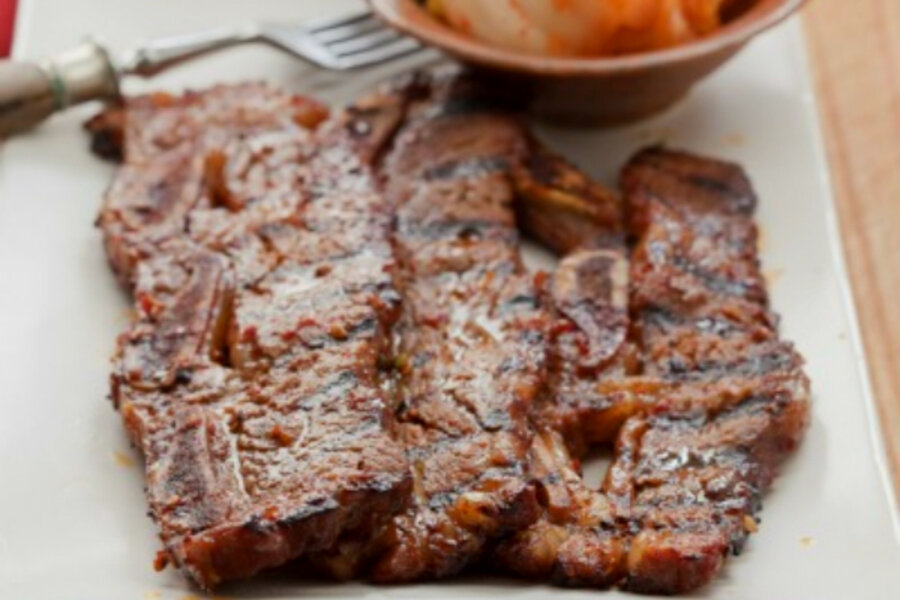Summer grilling with Korean-style beef short ribs
Loading...
Here in Seattle, we don’t expect summer – the most elusive of all seasons – to make a gracious appearance until after July 4th.
Now after Independence Day, I am happy to report that the days have been gloriously sunny! The temps have rolled into the 70s and 80s degree F., and we’re even starting to complain about the heat.
While true Seattleites have no qualms about being pelted by raindrops while guarding the grill, it’s always more pleasant when skies are blue and steaks aren’t sodden.
I know better than to take our gorgeous weather for granted so we have a few outdoor-centric activities planned for the next few days and that, of course, includes a barbecue.
Call me a snob but I’m not a burgers and hotdogs (bratwurst, yes, but I don‘t consider them one and the same) kinda gal. I prefer sate, pork chops, and chicken wings – foods we always had at our family barbeques growing up. That being said, my husband usually insists on throwing some patties and buns on the grill, “just in case people don’t care for sate.” Seriously?
Sure, it involves more prepping and elbow grease – as chief marinator and head sate-skewerer, I should know – but if you gather family and friends, it makes for easy work and a fun evening of chattering and gossip. And who could argue that tender, deeply marinated chicken morsels – flame-licked and kaffir lime-spiked – dipped into peanut sauce isn’t heaven on a hot and sticky summer’s day, or at anytime, really?
Now that I have you salivating over chicken sate, I’m going to tell you about a relatively new addition to my grilling repertoire – kalbi or Korean-style beef short ribs (sorry!).
To be honest, I don’t eat much red meat but I’ll happily eat kalbi. For some reason, my taste buds don’t register kalbi as beef. Similarly, rare flank steak or oxtail don’t taste beefy to me either.
I’ve eaten kalbi at Korean restaurants, and every time I’ve marveled at the meat so tender it melted like butter in my mouth.
Fortunately, I didn’t have to wonder for very long.
I was enlightened when my friend and fellow food-writer extraordinaire Susan Kim shared her grandma’s kalbi recipe (and a few more) with me for “The Asian Grandmothers Cookbook.” The revelation was extraordinary, much like an initiation into a reverent circle of all-knowing Asian grandmas, which producing the cookbook was! It seems that every Korean grandmother has her own secret to tenderizing meat, ranging from soda (Coke or 7-up) to Asian pears, and in Sang Jung Choi’s case, kiwis. (Curious if kiwis are native to Korea? So was I, and as it turns out, they are.)
These methods and ingredients may seem unorthodox to the American cook but trust me, the results are impressive.
So what are you waiting for? It’s time to get grillin’!
Korean Barbequed Beef Short Ribs (Kalbi)
All Korean grandmothers have their own little secrets for making and tenderizing kalbi. Soda, sugar, and Asian pears are all common tenderizing agents. Grandma Sang Jung Choi massages kiwis into Korean-style short ribs – beef ribs cut about 1/4-inch thick across the bone (instead of between bones) with three bones per slice – they are often available in Asian markets. Your butcher may also have the similarly cut flanken-style or cross-cut beef chuck short ribs; just ask if the slices can be cut a little thinner. Kalbi is lovely with cabbage kimchi.
Time: 30 minutes plus marinating
Makes: 6 to 8 servings as part of a multicourse family-style meal
4 pounds Korean-style beef short ribs
2 kiwis, peeled and pureed in a blender
2 tablespoons light brown sugar
1/2 cup soy sauce
6 cloves garlic, finely chopped (2 tablespoons)
1-inch piece fresh ginger, grated (1 tablespoon)
2 tablespoons toasted sesame seeds
2 tablespoons toasted sesame oil
1 tablespoon honey
1 tablespoon Korean red pepper powder
1/4 teaspoon ground black pepper
20-ounce bottle lemon-lime soda
Vegetable oil for brushing
Using your hands, massage the short ribs with the kiwi purée. Sprinkle each piece evenly with sugar and let sit while you make the marinade.
In a medium bowl, mix together the soy sauce, garlic, ginger, sesame seeds, sesame oil, honey, red pepper powder, pepper, and soda. Place the ribs in a single layer in a wide shallow pan and pour the marinade over, turning to coat. Cover with plastic wrap and marinate in the refrigerator, turning occasionally, for at least 1 hour, or preferably 12 hours.
Prepare a medium charcoal fire (you can hold your hand over the rack for no more than 3 or 4 seconds) with the rack 4 to 6 inches from the coals, or preheat a gas grill to medium. While the grill is heating up, drain the ribs from the marinade. Reserve the marinade for basting, if desired.
Brush the grill rack with oil and grill the ribs in batches until they turn caramel brown and develop slightly charred edges, 6 to 8 minutes on each side. Baste with the reserved marinade during the first 10 minutes of grilling if you like.
Pat’s Notes: If you prefer, omit the soda and add more sugar or honey for a little extra sweetness.
Related post on The Asian Grandmothers Cookbook: Sticky Spareribs








